
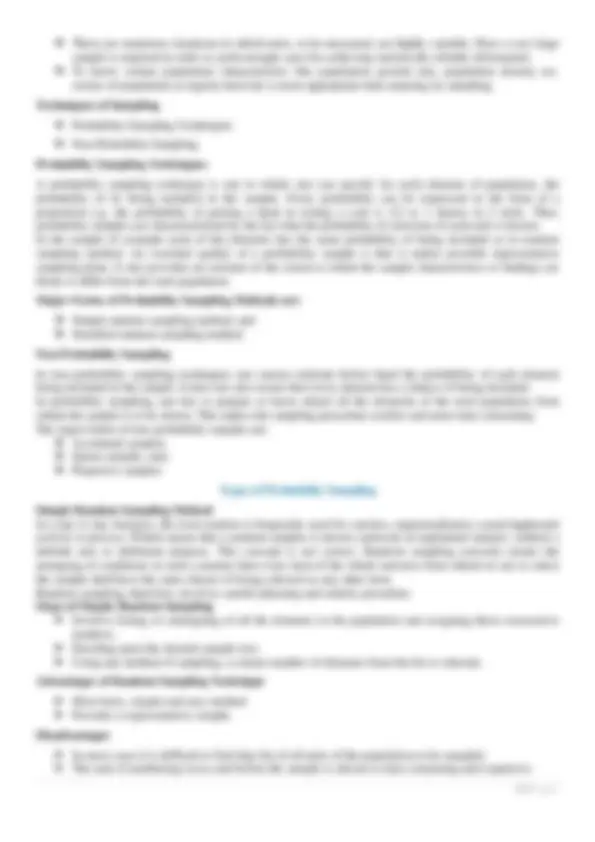

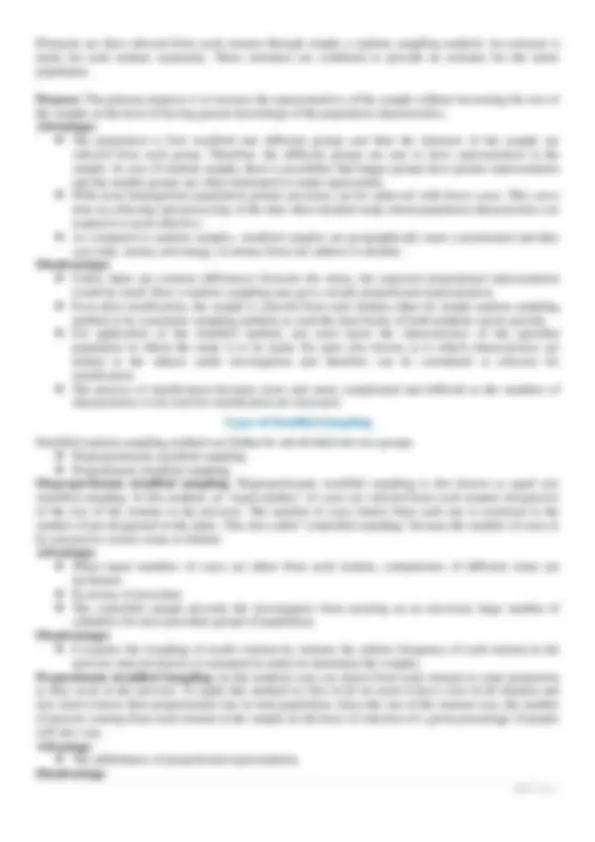
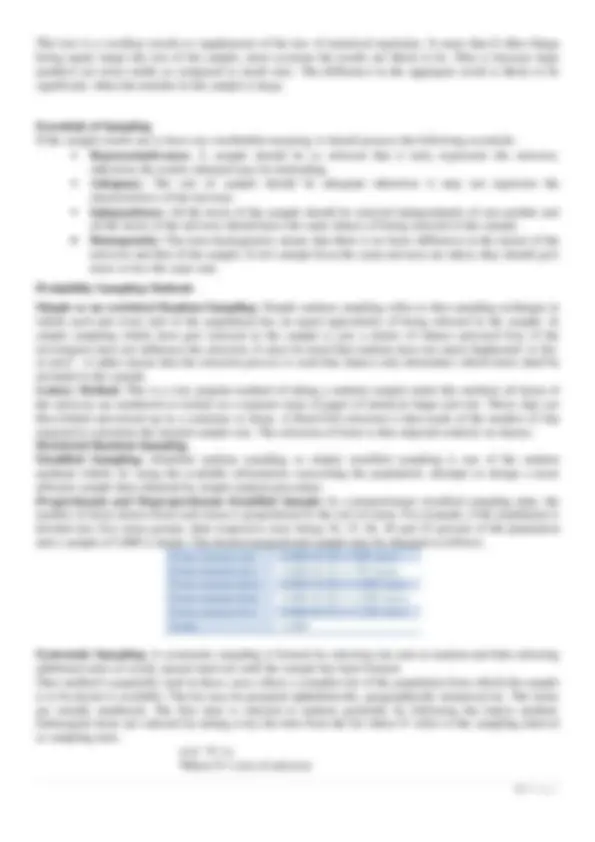
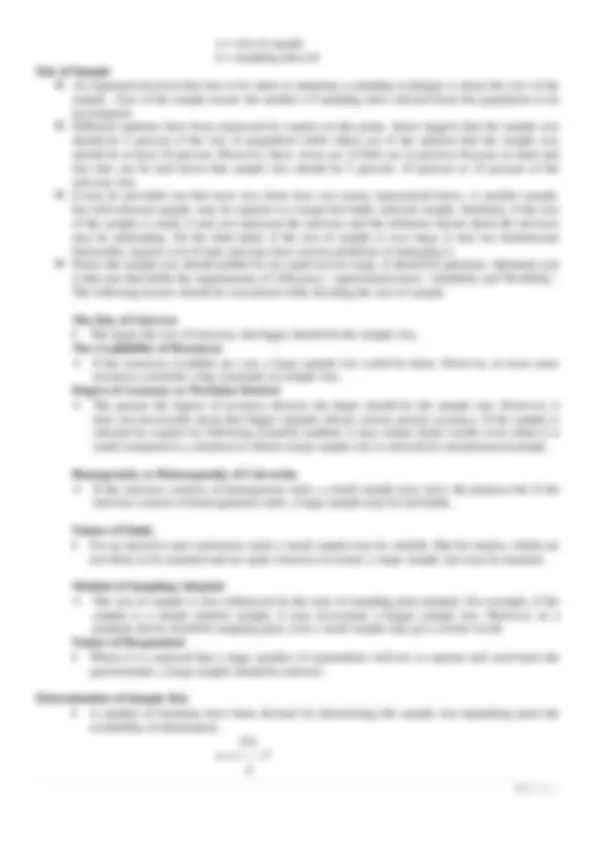
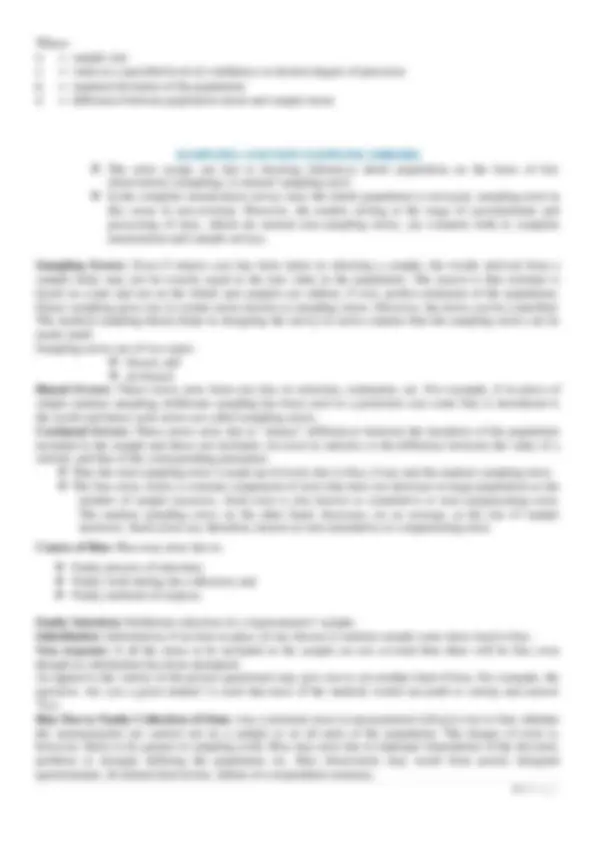


Study with the several resources on Docsity

Earn points by helping other students or get them with a premium plan


Prepare for your exams
Study with the several resources on Docsity

Earn points to download
Earn points by helping other students or get them with a premium plan
Community
Ask the community for help and clear up your study doubts
Discover the best universities in your country according to Docsity users
Free resources
Download our free guides on studying techniques, anxiety management strategies, and thesis advice from Docsity tutors
Theory of sampling in define their concepts, characteristics, advantages, disadvantages and different techniques and methods in sampling theory.
Typology: Lecture notes
1 / 12

This page cannot be seen from the preview
Don't miss anything!







Dr. SANJEEV KUMAR, Department of Economics, LU Meaning: In simple words sampling consists of obtaining information from a larger group or a universe. A social researcher has to collect information about a universe that consists of vast, differentiated population spread over a large territory and that too with in a limited amount of time and money. Measuring or collecting information from each and every member of such a vast population is, therefore, always not possible. It is known that part of a whole can give sufficient dependable information if the procedures followed in collection the part has of been scientific. What should be the desired characteristics of a Sample? ❖ A proper sample must give a precise but correct picture of the population from which it is drawn. ❖ The sample must be obtained by probability process. This would permit the use of statistical procedures to describe and analyze the sample data. ❖ The sample should be as small as precision considerations permit ❖ It should be as economical as possible and gathered swiftly to be completed within the time schedule. Concepts used in Samplings The following concepts are used in sampling designs ❖ Universe or population ❖ Stratum ❖ Elements, and ❖ Sample Universe In sample language, a population or universe can be defined as any collection of persons or objects or event in which one is interested. In other words a population consists of the people who are related to the specific problem under investigation. For example, if we are studying the relationship between the class achievements of the university students and the methods of teaching then the students of any place and of any time will come under our population. If we are studying the voting behaviour or political participation of the citizens of India then all the adult citizens of India, living in India or outside will come under population. Population Characteristics In research, we often speak in terms of population characteristics. e.g. age, sex, income, place of residences, caste, occupation population, size, denote etc. at the same time all of these characteristics are measured. What characteristics are to be measured depends upon the nature and type of problem under investigation. Types of Universe The universe, on the basis of characteristics, could be divided in to three types. ❖ Univariate population ❖ Bi-variate population ❖ Multivariate population Univariate population In which only one characteristic is considered, for studying at a time. The characteristic may be age, income, sex, T.V. listening habit, etc. Bi-Variate Population
The population can be defined as a bivariate type when we are measuring two characteristics simultaneously of each member. In sociology we often get interested to know how characteristics are related to each other or are associated with each other. For example, we want to know how crime going habit varies from urbanites to ruralities or how political participation is determined by degree of political awareness etc. Multivariate Universe A multivariate universe is the one in which we consider observations on three or more characteristics simultaneously. Several social factors together determine the occurrence of an event. e.g. a car accident on the road is often caused not only by the mechanical factor of the car but also by the other factors like, the drivers mental and physical condition, traffic volume, improper signals at crossing, pedestrians behaviour etc. similarly poverty is caused by several factors like big and fast growing population lack of proper industrialization according to the growing need of the population, discriminate distribution of wealth, etc. Stratum When the population is divided into several groups on the basis of one or several characteristics, we call each group as a stratum. Stratum can also be called as a sub population. A stratum may be defined by one or more specifications that divide a population into mutually exclusive segments. e.g. a given population may be divided into different stratums on the basis of the cinema going habit of the people viz. (a) males who visit cinema frequently,(b) males who rarely visit cinema; (c) males who visit cinema occasionally; (d) males who do not at all visit cinema. Thus the number of stratums would depend upon the number of characteristics included for stratification. Population Element By a population element we mean the units that make the population. Such units may be an individual, an object, or even a small group. Sample By sample we mean the aggregate of objects, persons or elements, selected from the universe. It is a portion or sub part of the total population. The following two methods are used to collect information about the population ❖ Census and; ❖ Sampling Census : When each and every element or unit of the population is studied Sampling: When a small part of the population is selected for study. Why Sampling? Advantages ❖ Helps to collect vital information more quickly. Even small samples, when properly selected, help to make estimates of the characteristics of the population in a shorter time. ❖ The modern world is highly dynamic, therefore, any study must be completed in short time, otherwise, by the time the survey is completed the situations, characteristics etc may have changed. ❖ It cuts costs; enumeration of total population is much more costly than the sample studies. ❖ Sampling techniques often increases the accuracy of data. With small sample, it becomes easier to check the accuracy of the data. Some sampling techniques/ methods make it possible to measure the reliability of the sample estimates from the sample itself. ❖ From the administrative point of view also sampling becomes easier, because it involves less staff, equipments etc. Disadvantages ❖ Sampling is not feasible where knowledge about each element or unit or a statistical universe is needed. ❖ The sampling procedures must be correctly designed and followed otherwise, what we call as wild sample, would crop up with mis-leading results. ❖ Each type of sampling has got its own limitations.
➢ The units need not only to be numbered but also arranged in a specified order. ➢ The possibility of obtaining a poor or misleading sample is always present when random selection is used. Methods of Drawing, Sample in Random Method Lottery Method: The numbers of all the elements of the universe are written on different tickets or pieces of paper of equal size shape and colour. which are then shuffled thoroughly in a box, or a container. Then tickets are then drawn randomly their numbers are noted and the corresponding individuals or objects are studied. Tippets Numbers: It was first developed by Prof L. H. C. Tippet and since then is known by his name. He developed a list of 10,400 sets of numbers randomly, each set being of four digits There numbers are written on several pages in unsystematic order. Grid Method: This method is applied in selection of the areas. Suppose we have to select any number of areas from a town or any number of towns from a province for survey. For selection, first a map of the whole area is prepared. The area is often divided into different blocks. A transparent plate is made equivalent to the size of the map that consists of several seqared holes in it which carries different numbers. By random sampling method it is decided as to which numbers are to be included in the sample. Systematic Sampling Method In this method first of all a list is prepared of all the elements of the universe on the basis of a selection criterion. A list may be prepared in alphabetical order, as given in the telephone directory. Then from the list every third, every tenth every twentieth or any number in the like manner can be selected. For the application of this method, preparing a list of all the elements and numbering them is essential. Secondly, the population needs to be homogenous in nature. Social phenomenon is variable in nature and individuals are heterogeneous. However on their social characteristics they are homogenous viz. we may decide to cover only the students, the professors, the slum dwellers etc. The characteristics to be selected for this purpose must be relevant to the problem under study. Advantages ➢ It is frequently used because it is simple, direct and in- expensive. ➢ When a list of names or items is available, systematic sampling is often an efficient approach. Disadvantages ➢ One should not use systematic sampling in case of exploring unfamiliar areas because listing of elements is not possible ➢ When there is a periodic fluctuation in the characteristic under examination in relation to the order in which the items appear, the methods is ineffective Stratified Random Sampling Method Definition: When the population is divided into different strata or groups and then samples are selected from each stratum by simple random sampling procedure or by regular interval method, we call it as stratified random sampling method. According to the nature of the problem relevant criteria are selected for stratification. Among the possible stratifying criteria, cum age, sex, family income, number of years of education, occupation, religion, race, place of residence etc. On the basis of characteristics universe can be divided into different strata or stratum, Each stratum has to be homogeneous from within such a division can be done on the basis of any single criterion. e.g. on the basis of age we can divide people into below 25 and above 25 groups, on the basis of education into matriculates and non matriculates etc. Stratification can also be done on the basis of a combination of any two or more criteria viz. on the basis of sex and education, we can divide the people into four groups. ❖ Educated women ❖ Un-educated women ❖ Education men ❖ Un educated men
Elements are then selected from each stratum through simple a random sampling method. An estimate is made for each stratum separately. These estimates are combined to provide an estimate for the entire population. Purpose: The primary purpose is to increase the representatives of the sample without increasing the size of the sample on the basis of having greater knowledge of the population characteristics. Advantages ❖ The population is first stratified into different groups and then the elements of the sample are selected from each group. Therefore, the different groups are sure to have representation in the sample. In case of random sample, there is possibility that bigger groups have greater representation and the smaller groups are often eliminated or under represented. ❖ With more homogenous population greater precision can be achieved with fewer cases. This saves time in collecting and processing of the data when detailed study about population characteristics are wanted it is more effective. ❖ As compared to random samples, stratified samples are geographically more concentrated and thus save time, money and energy, in money from one address to another. Disadvantages ❖ Unless there are extreme differences between the strata, the expected proportional representation would be small. Here a random sampling may give a nearly proportional representation. ❖ Even after stratification, the sample is selected from each stratum either by simple random sampling method or by systematic sampling method; as such the draw backs of both methods can be present. ❖ For application of the stratified method, one must know the characteristics of the specified population in which the study is to be made. He must also known as to which characteristics are related to the subject under investigation and therefore can be considered as relevant for stratification. ❖ The process of stratification becomes more and more complicated and difficult as the numbers of characteristics to be used for stratification are increased. Types of Stratified Sampling Stratified random sampling method can further be sub divided into two groups ❖ Disproportionate stratified sampling ❖ Proportionate stratified sampling Disproportionate stratified sampling: Disproportionate stratified sampling is also known as equal size stratified sampling. In this method, an "equal number" of cases are selected from each stratum irrespective of the size of the stratum in the universe. The number of cases drawn from each one is restricted to the number of pre designated in the plans. This also called "controlled sampling" because the number of cases to be selected in various strata us limited. Advantages ❖ When equal numbers of cases are taken from each stratum, comparisons of different strata are facilitated. ❖ Economy of procedure ❖ The controlled sample prevents the investigators from securing an un necessary large number of schedules for most prevalent groups of population. Disadvantages ❖ It requires the weighing of results stratum by stratum, the relative frequency of each stratum in the universe must be known or estimated in under tto determine the weights. Proportionate stratified Sampling: In this method cases are drawn from each stratum in same proportion as they occur in the universe. To apply this method we first of all we need to have a list of all striatum and also need to know their proportionate size in total population. Since the size of the stratum vary, the number of persons coming from each stratum in the sample on the basis of selection of a given percentage of people will also vary. Advantage ❖ The definiteness of proportional representation. Disadvantage
social groups etc. The basis purpose of quota sampling is the selection of a sample that no true replace of the population about which one wants to generalize. Advantage ❖ If properly planned and executed, a quota sample is most likely to give maximum representative sample of the population. ❖ In purposive sampling one picks up the cases that are considered to be typical of the population in which to one is interested. ❖ The cases are judged to be typical on the basis of the need of the researcher. ❖ Since the selection of elements is based upon the judgment of the researcher, the purposive sampling as called judgment sample. ❖ The researcher trees in his sample to match the universe in some of the important known characteristics. Disadvantage ❖ The defect with this method is that the researcher can easily make esser in judging as to which cases are typical. Purposive Sampling "Deliberate Sampling" or "Judgment Sampling". ❖ When the researcher deliberately selects certain units from the universe, it is known as purposive sampling. ❖ However, it must be kept in mind that the units selected must be representative of the universe. ❖ That, the names may be selected from a Telephone Diretory, Automobile Registration Records (RTOs) etc. Advantage ❖ Quote sampling is a stratified cum purposive sampling and thus enjoys the benefits of both samplings. ❖ It proper controls or checks are imposed, it is likely to give accurate results. ❖ It is only useful method when no sample frame is available. Convenience Sampling It is known as unsystematic, careless, accidental or opportunistic sampling. Under this a sample is selected according to the convenience of the investigator. May be use when ❖ Universe is not clearly defined ❖ Sampling units are not clear ❖ Complete source list is not available SAMPLING: THEORETICAL BASIS Theoretical Basis of Sampling ❖ On the basis of sample study we can predict and generalise the behaviour of mass phenomenon. ❖ This is possible because there is no statistical population whose elements would vary from each along without limit. ❖ Though we final diversity is a universal quality of mass data, every population has characteristic properties with limited variation. ❖ Thus makes possible to select a relatively small unbiased random sample that can portray fairly well. There are two important laws on which the theory of sampling is based: Law of 'statistical Regularity’ , and; Law of 'Inertia of Large Number’. Law of 'Statistical Regularity’ This law says that if a sample is taken, at random, from a population, it is likely to possess almost the same characteristics as that of the population. The size of sample should be 'moderately large'. Law of Inertia of Large Number
This law is a corollary (result or supplement) of the law of statistical regularity. It states that if other things being equal, larger the size of the sample, more accurate the results are likely to be. Thus is because large numbers are more stable as compared to small ones. The difference in the aggregate result is likely to be significant, when the number in the sample is large. Essentials of Sampling If the sample results are to have any worthwhile meaning, it should possess the following essentials.
Where n = sample size z = value at a specified level of confidence or desired degree of precision = standard deviation of the population d = difference between population mean and sample mean. SAMPLING AND NON SAMPLING ERRORS ❖ The error assign out due to drawing inferences about population on the basis of few observations (sampling), is termed 'sampling error'. ❖ In the complete enumeration survey since the whole population is surveyed, sampling error in this sense in non-existent. However, the mainly arising at the stage of ascertainment and processing of data, which are termed non-sampling errors, are common both in complete enumeration and sample surveys. Sampling Errors: Even if utmost care has been taken in selecting a sample, the results derived from a sample study may not be exactly equal to the true value in the population. The reason is that estimate is based on a part and not on the whole and samples are seldom, if ever, perfect miniature of the population. Hence sampling gives rise to certain errors known as sampling errors. However, the errors can be controlled. The modern sampling theory helps in designing the survey in such a manner that the sampling errors can be made small. Sampling errors are of two types: ❖ biased, and ❖ un-biased Biased Errors: These errors arise from any bias in selection, estimation, etc. For example, if in place of simple random sampling, deliberate sampling has been used in a particular case some bias is introduced is the result and hence such errors are called sampling errors. Un-biased Errors: These errors arise due to "chance" differences between the members of the population included in the sample and those not included. An error in statistics is the difference between the value of a statistic and that of the corresponding parameter. ❖ Thus the total sampling error is made up of errors due to bias, if any and the random sampling error. ❖ The bias error, forms a constant component of error that does not decrease in large population as the number of sample increases. Such error is also known as cumulative or non-compensating error. The random sampling error, on the other hand, decreases, on an average, as the size of sample increases. Such errors are, therefore, known as non-cumulative or compensating error. Causes of Bias: Bias may arise due to: ❖ Faulty process of selection; ❖ Faulty work during the collection; and ❖ Faulty methods of analysis Faulty Selection: Deliberate selection of a 'representative' sample. Substitution: Substitution of an item in place of one chosen in random sample some times lead to bias. Non response: It all the items to be included in the sample are not covered then there will be bias even though no substitution has been attempted. An appeal to the variety of the person questioned may give rise to yet another kind of bias. For example, the question. Are you a good student? is such that most of the students would succumb to variety and answer 'Yes'. Bias Due to Faulty Collection of Data: Any consistent error in measurement will give rise to bias whether the measurements are carried out on a sample or on all units of the population. The danger of error is, however, likely to be greater in sampling work. Bias may arise due to improper formulation of the decision, problem or strongly defining the population etc. Bias observation may result from poorly designed questionnaire, ill trained interviewer, failure of a respondents memory.
Bias in Analysis: In addition to bias, which arises from faulty process of selection and faulty collection of information, faulty methods of analysis may also introduce such bias. Such bias can be avoided by adopting the proper method of analysis. Avoidance of Bias: If the possibility of bias exists, fully objective conclusion cannot be drawn. The first essential of any sampling or census procedure must, therefore, be the elimination of all sources of bias. Method of Reducing Sampling Errors Once the absence of bias has been ensured, attention should be given to the random sampling errors. Such errors must be reduced to the minimum so as to attain the desired accuracy. Apart from reducing errors of bias, the simplest way of increasing the accuracy of a sample is to increase its size. The sampling error usually decreases with increase in sample size, and infact in many situations the decrease is inversely proportional to the square root of the sample size. Sample Size From this diagram it is clear that though the reduction in sampling error is substantial for initial increases in sample size, it becomes marginal after a certain stage. In other words, considerably greater effort is needed after a certain stage to decrease the sampling error this is the initial instance. From this point of view it could be said that there is a strong case for resorting to a sample survey to provide estimates within permissible margins of error instead of a complete enumeration survey. Non Sampling Errors As regards non-sampling errors they are likely to be more in case of complete enumeration survey than in case of a sample survey. When a complete enumeration of units in the universe is needs, one would expect that it would give rise to date free from errors. However, in practice it is not so. For example, it is difficult to completely avoid errors of observation or ascertainment. Similarly, in the processing of data, tabulation errors may be committed, affecting the final result. Errors arising in this manner are termed as non-sampling errors. Non-sampling error can occur at every stage of planning and execution of census or survey. Such errors can arise due to a number of causes such as defective methods of data collection, and tabulation, faulty definition, incomplete coverage etc. More specifically, non-sampling errors may arise from one or more of the following factors: Data specification may be inadequate and inconsistent with respect to the objectives of the study. Inaccurate or inappropriate method of interview, observation or measurement with inadequate on ambiguous schedules. Lack of trained and experienced investigators. Lack of inadequate inspection and supervision of primacy staff. Errors due to non-response. Errors in data processing operations. Errors committed during presentation and printing of tabulated results. Control of Non Sampling Errors: In some situations the non-sampling errors may be large and deserve greater attention than sampling errors. While, in general, sampling error decrease with increase in sample size, non-sampling error tends to increase with the sample size. Sampling Error